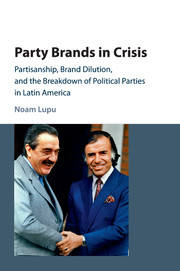 Party Brands in Crisis
Party Brands in Crisis Book contents
- Frontmatter
- Dedication
- Contents
- List of figures
- List of tables
- Acknowledgments
- 1 Why do parties break down?
- 2 Brand dilution and party breakdown
- 3 Explaining party breakdown across Latin America
- 4 Argentina: Peronism survives, Radicals collapse
- 5 Venezuela: AD and COPEI break down
- 6 Party brands and mass partisanship: experimental evidence
- 7 Party brands and mass partisanship in comparative perspective
- 8 Parties, partisanship, and democracy: conclusions
- Appendix
- Bibliography
- Index
4 - Argentina: Peronism survives, Radicals collapse
Published online by Cambridge University Press: 18 December 2015
- Frontmatter
- Dedication
- Contents
- List of figures
- List of tables
- Acknowledgments
- 1 Why do parties break down?
- 2 Brand dilution and party breakdown
- 3 Explaining party breakdown across Latin America
- 4 Argentina: Peronism survives, Radicals collapse
- 5 Venezuela: AD and COPEI break down
- 6 Party brands and mass partisanship: experimental evidence
- 7 Party brands and mass partisanship in comparative perspective
- 8 Parties, partisanship, and democracy: conclusions
- Appendix
- Bibliography
- Index
Summary
I did things I wouldn't have done had it not been for the fear of instability, and I didn't do things I would [otherwise] have done, because I had the obligation to consolidate democracy.
– Raúl Alfonsín (UCR), quoted in McGuire (1997: 203)In Argentine politics there were three phases … Monogamy is the first phase, the strong parties of 1983, one center-left, one center-right, attachments, identities; the second I would call polygamy and here began the alliances … [By 2003] we got to the orgy, which cannot be described sociologically because there are no behavioral regularities, just anything goes.
– Eduardo Fidanza, personal interview, November 19, 2009When Argentina redemocratized in 1983, its established political parties returned to contest elections. The Radical Civic Union (UCR), founded in 1891, emerged as a party of middle-class sharecroppers and small farmers threatened by the influx of European immigrants (Persello 2007).With the rise of Peronism in the 1940s, Argentina's oldest mass party formed the basis of the middle- and upper-class opposition to Juan Domingo Perón.
The Peronist party – officially called the Justicialist Party (PJ) – was the electoral vehicle founded by Perón in the 1940s. Proscribed on and off from openly competing in elections in the intervening decades, the party drew its electoral support from the rural poor and urban working classes (Lupu and Stokes 2009), developing corporatist and patronage ties to the Argentine labor movement. Its elites often relied on nationalist rhetoric promoting statist economic development, a “revolution in production,” and redistributive social justice (McGuire 1997).
To be sure, both the established Argentine parties were heterogeneous and, at times, inconsistent in these positions. Both also suffered various internal conflicts that sometimes fractured the party. For some scholars of Argentina, the distinction between the parties was one of rhetoric rather than ideology (Ostiguy 2009).
Rhetoric, ideology, and class appeal often went hand in hand, however. Whereas Radicals appealed to the upwardly mobile middle classes by promoting labor flexibility and strengthening democratic institutions (Gibson 1996), Peronism appealed to popular sectors with corporatism and nationalist rhetoric (Mora y Araujo 1995). In September 1986, nearly 50 percent of survey respondents named the UCR as “the party most bound to privileged sectors”; only 8 percent named the PJ.
- Type
- Chapter
- Information
- Party Brands in CrisisPartisanship, Brand Dilution, and the Breakdown of Political Parties in Latin America, pp. 59 - 100Publisher: Cambridge University PressPrint publication year: 2016
